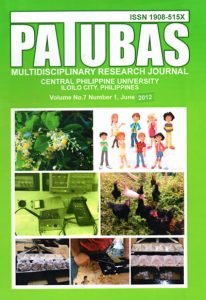
Patubas is published once a year under the auspices of Central Philippine University, Jaro, Iloilo City, Philippines.
Copyright © 2012 by individual authors and Patubas.
Published in 2012
Central Philippine University
Lopez Jaena, St., Jaro, Iloilo City
All rights reserved. No part of this publication may be reproduced or transmitted in any form or by any means, electronic or mechanical, including photocopy, recording or any information storage and retrieval system, without permission in writing from the authors or publisher.
For print ISSN 1908-515X
Publication ISSN 2672-3611
Opinions and facts contained in the articles published in this issue of Patubas are the sole responsibility of the individual authors and not of the Editorial Board, Patubas or Central Philippine University.
Aries Roda D. Romallosa and Kristofer John C. Hornada
ABSTRACT
This study was conducted to produce briquettes as alternative source of energy from abundant biomass and urban wastes using a locally fabricated household briquette molder which is composed of molders, handle and frame. The mixtures used were the following Briquette 1: paper (100%); : Briquette 2: carbonized rice husk or CRH (71%) + cornstarch (29%); Briquette 3: Sawdust (71%) + cornstarch (29%); Briquette 4: paper (50%) + CRH (50%); Briquette 5: paper (50%) + sawdust (50%); and Briquette 6: paper (50%) + CRH (25%) + sawdust (25%). Smaller sizes of balled homogeneous materials were placed into each of the molder of the machine. The materials were compacted by closing and pressing down the movable upper half portion of the molder then the briquettes produced were placed on trays for sundrying until ideal for fuel use. Briquettes 1 (Paper), 5 (Paper + Sawdust), and 6 (Paper + CRH + Sawdust) were found to be the most viable mixtures. This is based on practicality of production requirements and high production rate, better quality of fuel produced, fast operating performance in terms of boiling water and cooking rice and potential earnings that may be gained when adopted as an income generating project.
Nenalyn D. Abioda and Carolyn L. Yoro
ABSTRACT
The main objective of this study was to assess the knowledge of and attitude towards Reproductive Health (RH) and their relationship to the health seeking behavior of adolescents in all high schools in Iloilo City. This is a descriptive-relational study that used the one-shot survey design. The respondents were the 332 randomly selected fourth year students enrolled in private and public high schools supervised by DepEd and Higher Education Institutions with high school department in Iloilo City for SY 2007-08. Results revealed that the majority of the students belong to the younger age group, are females, enrolled in public high school and residing within Iloilo City; had average level of knowledge about RH, had neutral attitude towards RH, and with good health seeking behavior. A significant relationship existed between: the type of school where the students are enrolled and their knowledge about and attitude towards RH; students’ sex, type of school where they are enrolled, location of residence, attitude and their health seeking behavior; knowledge about and their attitude towards RH. No significant relationship existed between: the students’ age, sex and location of residence and their knowledge about and attitude towards RH; students’ age and knowledge about RH and health seeking behavior; and knowledge about RH and their health seeking behavior when attitude was controlled.
Reynaldo N. Dusaran and Randy A. V. Pabulayan
ABSTRACT
This study was conducted to determine the production practices of the native chicken growers in the top three native chicken municipalities of all provinces in Western Visayas. This is a purely descriptive study that utilized the one-shot survey design. Multi-stage sampling technique was used to identify the study respondents. Face to face interview of the native chicken raisers was conducted. Data analysis was purely descriptive. Results show that there are specific areas in the region where the production of native chicken predominates. The income of the native chicken growers is relatively low since native chicken production is still a backyard family economic undertaking with limited marketable product volume. The growers have an average of 16.2 heads of hens and 4.4 heads of roosters for breeding. Their breeders, mostly home grown, were mostly upgraded native chicken, followed by Darag and Jolo. Native chickens are generally raised in free range. The usual feedstuffs consisting of corn/cracked corn, rice bran, home mixed ration, filled/unfilled palay and rice/milled rice were more or less the same for pullets, cockerels, hens and roosters but amount varies depending on the stage of growth of chickens. These feeds are generally broadcast on the ground. Higher incidence of mortality peaking in June was largely attributed to change in climate, diseases and pests. Generally, the growers did not vaccinate but they provided their native chickens with substances for disease prevention and control. More pullets and cockerels are sold and seasonality was also observed. The native chicken growers have plans for expansion.
Ernesto S. Elefan
ABSTRACT
This study was carried-out to determine the early growth response of Beauty Leaf (Calophyllum inophyllum L.) to five biofertilizers namely Azotobacter, Bio Green, MyKo Vam, Vam Root Inoculant, and Bio N when compared with the Untreated control. Treatments were laid-out in a Randomized Complete Block Design, each replicated three times. Results showed that plant height and root length did not significantly vary among plants fertilized with Azotobacter, Bio Green, MykoVam, and Vam Root but significantly differ from those applied with Bio N and Untreated-control. Plants in all biofertilizers had comparable shoot dry matter weight but were significantly better from the Untreated control. Significantly highest root dry weight was registered by the Azotobacter-fertilized beauty leaf. Final leaf count, shoot base diameter, fresh shoot and root biomass, however, did not differ significantly among all treatments. Based on the results, Azotobacter, Bio Green, MyKoVam, and Vam Root Inoculant are potential biofertilizers for Beauty leaf under a screen house condition.
Alberto A. Java, Ramon A. Alguidano, Jr., Caesar Rico S. Acanto, Ruben M. Armadillo & Vitini Edhard O. Idemne
ABSTRACT
The study aimed to design and construct a locally-made battery charge controller for the Battery Charging Station (BCS) project implemented by Central Philippine University-Affiliated Non-conventional Energy Center (CPU-ANEC). The battery charge controller was designed only to protect the battery from over-charging. The functionality of the charge-controller was tested using a solar panel and a battery. The charging current was controlled by the PWM circuit. During charging, the output of the PWM circuit was both set approximately to ten percent (10%) duty cycle for charging ninety percent (90%) duty cycle for trickle charging. The output waveform and the duty cycle of the PWM circuit were checked using the oscilloscope. Testing of the charge-controller was done for four days of continuous operation to ensure the reliability of the system. Based on the test results, when the duty cycle was ten percent (10%), the green LED lighted-up and the ammeter indicated maximum charging current, while for the ninety percent (90%) duty cycle, a yellow LED light-up indicating minimum current. The red LED light-up when the polarity of the battery was reversed, while the orange LED lightedup only when the battery state of charge was empty. These test results show that the battery charge-controller worked as expected by meeting the required design parameters. The unit is now ready for use.
